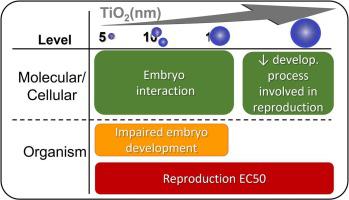NanoImpact ( IF 4.9 ) Pub Date : 2023-02-27 , DOI: 10.1016/j.impact.2023.100458 Susana I L Gomes 1 , Carlos P Roca 2 , Suman Pokhrel 3 , Lutz Mädler 3 , Janeck J Scott-Fordsmand 2 , Mónica J B Amorim 1

|
The hazards of nanomaterials/nanoparticles (NMs/NPs) are mostly assessed using individual NMs, and a more systematic approach, using many NMs, is needed to evaluate its risks in the environment. Libraries of NMs, with a range of identified different but related characters/descriptors allow the comparison of effects across many NMs. The effects of a custom designed Fe-doped TiO2 NMs library containing 11 NMs was assessed on the soil model Enchytraeus crypticus (Oligochaeta), both with and without UV (standard fluorescent) radiation. Effects were analyzed at organism (phenotypic, survival and reproduction) and gene expression level (transcriptomics, high-throughput 4x44K microarray) to understand the underlying mechanisms. A total of 48 microarrays (20 test conditions) were done plus controls (UV and non-UV). Unique mechanisms induced by TiO2 NPs exposure included the impairment in RNA processing for TiO2_10nm, or deregulated apoptosis for 2%FeTiO2_10nm. Strikingly apparent was the size dependent effects such as induction of reproductive effects via smaller TiO2 NPs (≤12 nm) - embryo interaction, while larger particles (27 nm) caused reproductive effects through different mechanisms. Also, phagocytosis was affected by 12 and 27 nm NPs, but not by ≤11 nm. The organism level study shows the integrated response, i.e. the result after a cascade of events. While uni-cell models offer key mechanistic information, we here deliver a combined biological system level (phenotype and genotype), seldom available, especially for environmental models.
中文翻译:

TiO2 纳米粒子的库毒性(紫外线和非紫外线照射)——高通量体内转录组学揭示机制
纳米材料/纳米粒子 (NMs/NPs) 的危害主要使用单个 NMs 进行评估,并且需要使用许多 NMs 的更系统的方法来评估其在环境中的风险。NM 库具有一系列已识别的不同但相关的字符/描述符,可以比较许多 NM 的效果。在土壤模型Enchytraeus crypticus上评估了包含 11 个 NM 的定制设计的掺杂 Fe 的 TiO 2 NM 库的效果(Oligochaeta),有和没有紫外线(标准荧光)辐射。在生物体(表型、存活和繁殖)和基因表达水平(转录组学、高通量 4x44K 微阵列)分析影响,以了解潜在机制。总共进行了 48 个微阵列(20 个测试条件)以及对照(UV 和非 UV)。TiO 2 NPs 暴露诱导的独特机制包括对 TiO 2 _10nm的 RNA 加工损伤,或对 2%FeTiO 2 _10nm的细胞凋亡失调。非常明显的是尺寸依赖性效应,例如通过较小的 TiO 2诱导生殖效应NPs (≤12 nm) - 胚胎相互作用,而较大的颗粒 (27 nm) 通过不同的机制引起生殖影响。此外,吞噬作用受 12 和 27 nm NPs 的影响,但不受 ≤11 nm 的影响。有机体水平研究显示综合反应,即一系列事件后的结果。虽然单细胞模型提供了关键的机械信息,但我们在这里提供了一个组合的生物系统水平(表型和基因型),很少有,特别是对于环境模型。



























 京公网安备 11010802027423号
京公网安备 11010802027423号